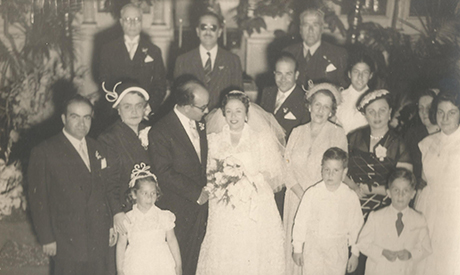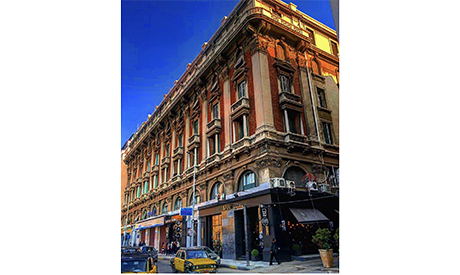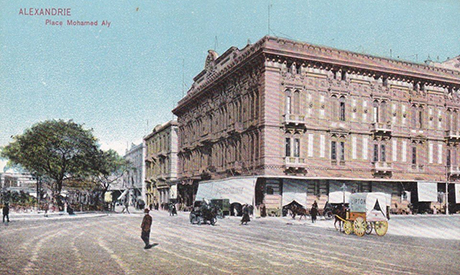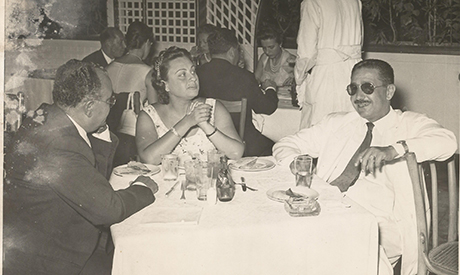With the live footage of people chanting Bella Ciao, or “Goodbye Beautiful”, from their balconies in Italy after the coronavirus outbreak in the country, Italians have not stopped singing away the pain and hard times like they have always done. This is an ingrained trait of the Italian people that makes them no different from the Egyptians in times of hardship. But what else do Italians and Egyptians, Alexandrians in particular, share?
A few weeks ago, just before the coronavirus crisis took over, I had the pleasure of meeting Nadim Kanawati, the grandson of Italian immigrants who arrived in Alexandria by ship in the 19th century, to find out what connects Italians and Egyptians together and discover a bond that remains very distinctive in Alexandria today.
Had you lived in neighbourhoods like Heliopolis and Zamalek in Cairo in the period between the world wars, then if you have fallen ill you could have gone to see a Syrian doctor. You could have bought your shoes from an Armenian trader, eaten Italian food, and been cooked for by a Greek chef in a restaurant owned by an English lady. You could have spoken French and Arabic with all kinds of neighbours of various religions and backgrounds.
In Alexandria, this diversity was even more intense. Different nationalities mixed and mingled with Egyptian society, the most distinguished of which were the Greeks and Italians. In fact, this was the foundation of inter-war Alexandria. On a tour around the Mansheya district of Alexandria named after the Italian architect Francesco Mancini, Kanawati accompanies me on a walk down memory lane.
We come first to St Catherine’s Cathedral, the Roman Catholic Cathedral located in the heart of Mansheya. Built in 1845 and inaugurated in 1847 and based on a mix of Neo-Baroque and Neo-classical styles by the Italian architect Father Serafino da Baceno, the façade that exists today was added in 1920 by architect Mario Avena. It is famous for being the burial place of exiled Italian king Victor Emmanuel III, also the name of a square in the Smouha district of Alexandria, before his remains were moved to Italy in 2017.

The wedding of Odette Pace, the sister of Nadim’s grandmother, 1954. Lady Pace is seen second from right, Nadim’s father, Samir Kanawati, as a little boy in shorts with his brother Karim and sister Marie Theresa (photo courtesy of Nadim Kanawati)
As we head to nearby ِAhmed Orabi Square, Kanawati recalls that “my paternal great-great grandfather Nicola Pace, who was Italian Maltese, arrived at this gate of east and west by ship with his parents Aloisio Pace, who was Italian, and his mother Lucrezia Laguna, who was Maltese. They came to live in this coastal cosmopolitan city in 1840.”
His great grandfather spent his childhood in Alexandria between 1867 and 1873 and got married when he was 22 years old at the same time that his parents’ business was flourishing. Pace married Josephina Calvara, an Austrian woman, giving birth to their first son Alfredo Pace, Kanawati’s great grandfather. When he was 18, Alfredo received British citizenship because Malta had been colonised by Britain. Later, he married Ivona Lafrance, who was French, and gave birth to Lilianna Pace, his grandmother, who married Charles Kanawati, who was Levantine.
Kanawati’s Italian descent played a notable role in his upbringing. He recalls that his great grandfather was one of the first Italians to graduate from the Italian College of Surgeons, the first surgeons college established in Egypt in Alexandria and connected to a similar one in Turin in Italy.

Cecil Hotel, Downtown Alexandria (photo: Hisham Abdel-Ati)
HISTORY
Meeting Osama Moharram, the founder of InMagazine in Alexandria two years ago, Kanawati and Moharam found they shared similar interests.
“As a group of young people passionate about history and liking to read a lot about it, we wanted to revive the history of Alexandria for young people in particular. So, we started brainstorming on how to make it more interesting for the younger generations, rather than just giving them information in the form of books,” Moharram said.
It was devastating to find out that many young people in Alexandria did not know much about the landmarks they passed by on a daily basis, and that they knew very little about the rich heritage of this cosmopolitan city.
After some disappointments because “no one is going to be interested in history, and you need a big budget to do it and the right tools,” and so on, Moharram and his team followed their passion and founded InMagazine as a cultural initiative in 2011, officially launching its website in 2013.
Breaking all the rules and ignoring all the put-downs, the InMagazine team has succeeded in creating more than eight exhibitions in Alexandria and an ongoing campaign called “Love Alexandria” to support tourism in the coastal city. In addition to a book called The Big Square, a number of projects including a tourist information centre, a gift shop, and a number of short documentaries on Alexandria have been created.

Italian-designed building, Fouad Street (photo: Mohamed Al-Sayed)
“We ignored all the setbacks and decided to follow our passion with the tools we had, starting by making short videos on old restaurants in Alex such as the Santa Lucia and Chez Gaby [Italian restaurants in the downtown area] and on some museums. That was until I met Nadim and another friend who wanted to collaborate on a project about the Italian community in Alex,” Moharram recalls.
InMagazine’s latest and biggest project is the result of two years of dedication, passion and hard work and is a film called L’Alessandria Degli Italiani, or “The Alexandria of the Italians.” Taking nine months of meticulous research on everything about the Italians in Alexandria, searching for documents, visiting places, and talking to Italians who still reside in Alex, the result was this fascinating film.
“The first screening was postponed a couple of times because as we were doing the research, we discovered more and more amazing facts and we could not just stop there. We had to dig for more, and I am sure that more is yet to be discovered,” Moharram said.
Finally coming to light last December at the annual celebration of Alexandria Heritage Days at the Centre d’Etudes Alexandrines (CEAlex) in Alexandria, the film was shown a second time at the AUC Tahrir Culture Centre in Cairo in January. The film was a hit, and the theatre was packed. “It showed a side of the Italians in Alexandria that no one has paid attention to. It was very touching,” said Alice Dimitri, 71 years old, who spent her childhood in Alexandria and flew from Italy to watch the film after she saw the trailer on Facebook.

Manshiya district (photo: Hisham Abdel-Ati)
The history of Alexandria is that of a cosmopolitan city, and since its founding in the Hellenistic Period it has been a metropolis for people from different cultures and backgrounds. Alexander the Great, who never saw the city grow, founded it and planned it as a city that would embrace diversity. The ancient Greeks and Egyptians lived together in peace in the city, treating each other with goodwill and sharing an atmosphere of social equality and brotherhood, whether in times of war or in trade relations and the exchange of goods.
Throughout history, the rulers of Egypt stressed the equality between the Egyptians and the Greeks and then between the Egyptians and the Romans after the Roman conquest until the Islamic and modern eras. Alexandria was the gate of east and west, the “Bride of the Mediterranean”, and its community stood out as cosmopolitan and multicultural.
“Greeks, Italians, Turks, Levantines and Jews all melted into Alexandrian society without any superior attitudes or condescending airs. Each had their own expertise: the Greeks were famous for making cheese and olive oil; the Italians were the architects; the Levantine were good traders; and so on,” said Islam Assem, a professor of history at the Higher Institute of Tourism in Abu Qir in Alexandria.
InMagazine’s 80-minute film sums up the history of the Italians in Alexandria, including their immigration to the city, escaping political turbulence at home, their lives in the city, their schools, places of worship, and houses, and, above all, their impact on the city’s artistic and cultural side, with an emphasis on Italian architecture, much of which is still present in today’s Alexandria. People always confuse Italian-designed landmarks in the city with Italianate ones. But the difference is huge, as an Italian-designed building is not necessarily Italianate in style.

Mohamed Ali Statue and Okelle Monasco in the background (photo courtesy of Allinari Archive)
Italian architects came to Alexandria, or some were born there, and many graduated from the Architecture School in Rome. All of them were excellent architects, not only in presenting works of Italianate-style architecture, but also in designing architectural gems that were a peculiar mix of elements, including Italian, Islamic, Jewish, Moorish or Indian. “The Italian architects who lived and worked in Alexandria were experts in designing what appealed to their community,” Assem said. “Many of the Greek-owned and Greek-style buildings were also built by Italian architects.”
The first wave of Italians arriving in Alexandria was mostly political refugees, as described by Italian journalist and political activist Fausta Cialente (1898-1994). “Exiles who, fleeing from the Pope or the Bourbons, had embarked at night in fishing boats from Barletta, or Taranto, or from the coast of Sicily, after weeks at sea disembarked in Egypt. I imagine them, the legendary fugitives of the last century, wrapped in their cloaks, with wide-brimmed hats and long beards. They were mostly professional men or intellectuals who after a while sent for their wives from Italy or else married local girls, including Syrians, Lebanese or Egyptians. Later on, their children and grandchildren founded charitable institutions in Alexandria, the people’s university, the civil cemetery, the first surgical hospital, and so on,” he wrote.

Okelle Monferrato (photo courtesy of George Meurillon Archive)
According to Cialente, these were the first Italians who crossed the Mediterranean in the first half of the 19th century to reach what survived of the trading outposts founded in the Middle Ages.
The second wave of Italians arriving in Alexandria were mainly invited by the Egyptian government at the time and given certain advantages in terms of investment and establishing businesses in the coastal city. Mohamed Ali Pasha, the early 19th-century ruler of Egypt, and his descendants trusted Italians in terms of serving the whole of Egypt, and Alexandria became the centre of their architectural and artistic works, playing a major role in construction and in society as a whole.
“They had the ability to merge into all classes of society. They were friends with the royal family; some were aristocrats, and others were from the working class. This was unlike the French in Alexandria, who viewed themselves as being part of the aristocratic class alone,” Kanawati said.

Charles Kanawati (Nadim’s Levantine grandfather) and Lady Liliana Pace (Nadim’s Italian-Maltese grandmother) with an Egyptian friend (photo courtesy of Nadim Kanawati)
ARCHITECTURE
Assem explained that Italian influences are obvious in almost every aspect of Alexandria. However, their major influence was on the architectural aspect of the city, he said.
“Besides the presence of Italian construction companies, Italian architects who designed masterpieces had an overwhelming presence, and most of the old buildings we see today in Alexandria were designed by the Italians, leaving Egypt with a magnificent number of architectural gems that have survived the test of time,” he added.
The Cecil Hotel, a downtown landmark, was designed by Giacomo Alessandro Loria in 1929, for example, a talented Italian architect who was born in Mansoura to Italian parents and spent all his career in Egypt. In the same year, Loria designed Bank Misr in Salah Salem Street in the Attarin district and the Little Venice building near Ramleh Station in the heart of Alexandria’s historical Eastern Harbour district.
According to Sigma Property, a company that has developed and reused heritage buildings to turn them into key pieces of urban infrastructure since 1992, “this building was awarded the best Municipality Honorary Prize for the best facades in 1929 and for its Moorish arches that live in perfect harmony with the Gothic detailing borrowed from the Palazzo Ducale in Venice. Along the corniche of the Eastern Harbour area, the Bank Misr building links the Island of Pharos to the mainland, and the faҫades are in a charming symphony of styles on the graceful semicircular shoreline, memorialising part of Alexandria’s cosmopolitan era.”
Loria returned to Alexandria in 1914 after studying in Tuscany, and he soon became one of the city’s most sought-after architects. He presented his Little Venice building (1926-1928) to the Saleh Salem family in addition to the Douak and Al-Nokali apartment blocks at Al-Raml Station.
Next to Little Venice is the Heikal building designed by Riccardo Smith, “another phenomenal case of Italianate Alexandria,” Sigma said. “Riccardo Smith’s practice with the wealthy Heikal family meant he built their apartment building along the tramway between Mansheya and Ramleh Square. Through the brick facade and coloured mosaics, this historicist revivalist experiment has its recognisable icon in the building’s orientation of form, projecting light and shade contrasts on the façade completed in 1929,” the company said.
Mario Rossi (1897-1961), another Italian architect, designed three of the most famous mosques in Alexandria, including the Al-Morsi Abul-Abbas Mosque in the Bahari district and the Al-Qaed Ibrahim in Ramleh Station. He also designed the shrine of the Al-Shatbi Mosque. Architect Ernesto Verucci Bey designed the Montazah Palace and renovated the Throne Hall in the Ras Al-Tin Palace during king Fouad’s reign in the 1920s.
“We cannot say that Alexandria was monopolised by the Italians in all aspects, as the Greeks for instance were famous for their grocery shops, where making cheese and olive oil was their specialty. But the Italian architects came from the Italian School of the Arts, and they were exceptional in architecture and design. Many French architects also came to Alexandria, but they specialised more in sculpture,” Assem said.
The main square in Alexandria was once the court of traders, merchants, and financiers. The sole exception is the Anglican Church, and all the other buildings are okelles, a Westernised form of the Arabic word wikala meaning commercial structures traditionally used for warehousing and trade. All the blocks are of approximately the same height; some have a traditional layout, such as the vast Okelle Moharram Bey, while others look more like European mansions. The architect Francesco Mancini, who excavated the area to lay the foundations for these okelles, is also believed to have designed their Neo-classical façades with base, central body, coping or pediment, and introduced Doric and Ionic ornamental pilasters or semi-columns.

Late 1880s photo taken in Alexandria of Cavaliere Nicola Pace, Nadim’s great grandfather, his wife and son Alfred, the father of Nadim’s grandmother
(photo courtesy of Nadim Kanawati)
Many have asked why the Neo-classical style was introduced in contrast to the Old Turkish Town and with the other styles then being introduced. It may have reflected Mancini’s training in Italy, and may also have been part of a classical revival, attempting to link this new stage in the life of the coastal city with its mythical Hellenistic past. It may have been the means to establish an architectural lingua franca to give a European touch to the new Alexandria.
“Italian architects, engineers, and builders emigrated from places of widely different historical origins, each with its own marked cultural identity and political and economic role. They came from the ports and capital cities of the states in Italy prior to unification, from Leghorn (such as the architect Avoscani), Trieste (Bocti), Venice (Lucovich), Genoa, Ancona (Cesari), Bari, Catania, Palermo, Turin, Florence (Falcini), and Naples; from towns like Voghera, Ferrara, Bologna, Modena, Carrara, Siena, and Ascoli Piceno; and from territories like Trento, Udine, and Gorizia,” Assem said.
As time went on, arrivals from Rome and Milan increased, while many architects were second- or third-generation Italians born in Egypt. Some never went to Egypt at all and prepared their projects in Italy. The training and cultural backgrounds of these Italians ranged between two extremes: the architect-artist (such as Avoscani) and the technician-builder (Bocti), whether the latter possessed a regular qualification or knowledge acquired solely through practice. Some had risen from the ranks of apprentices to more traditionally trained artists, whereas for others the family background played a fundamental role.
“Some of these pioneers (such as Mancini) came from military careers, but later arrivals had been trained in academies of fine arts and in polytechnic schools in Italy, each dominated by some emerging personality, architectural teaching having become a separate curriculum only in the 1920s. A few had a European-style education, while several were trained entirely in Egypt,” Assem said.
Later there was an appeal for change. Projects such as the Royal Littorie Schools in Alexandria (1931-1933), the Italian Schools in Cairo (1934), and the Casa d’Italia in Port Said (1936) were all designed by Clemente Busiri Vici and were important for the fascist regime in Italy in the 1920s and 1930s and aimed at strengthening links between Italians in Egypt and their homeland while associating the fascist ideology with a new spirit of national identity.
Italian journals and newspapers circulating in Egypt at the time show how the Littorie Schools in Alexandria were both an experiment and a manifesto: a community building of a new kind, where most of the social, cultural, and recreational activities of the Italian community were concentrated and where new behavioural patterns, including athletics and fascist youth associations, were encouraged. The schools had to function as a piece of the homeland, and their plain style was intended to mark a clean break with the revivalist architecture of the past.
The ground chosen for this school complex was situated in the Shatbyi area of Alexandria, where the British Boys School, the Greek complex, the St Mark’s College, and the Lycée Français already formed a “city of education”. Exceptional in size, the Littorie Schools housed nursery, primary and boarding schools, high schools, a library, a theatre for 2,000 people, and extensive sports facilities.
“Architect Busiri Vici concentrated the building in the higher half of the area, leaving the lower half for sports grounds. A symmetrical layout gave coordination to the spacing of the building volumes, which consisted of a series of pavilions connected by walkways to form a single structural complex,” Assem commented.
WHY ALEXANDRIA?
Alexandria has always been a cosmopolitan city, and it has always led by example.
“It was seen as a place of dreams and opportunities. Nowadays, Abu Dhabi has established a branch of the Louvre Museum, which leads people interested in the field of history and culture to study there. Dubai is leading a new architectural movement, building new infrastructure and making more people interested in the field look for jobs there. Alexandria served the same purpose in the past,” Assem said.
“After the bombardment of Alexandria by the British fleet in 1882 there was a need for the reconstruction of the city, and more Italians and French started to arrive. The ancient Bibliotheca and most of ancient Greek Alexandria was nothing but heaps of ash, and most of the foreign communities living in Alexandria lost their buildings after the bombardment,” Assem added.
Today, old men in Bahari in Alexandria can still sometimes be heard saying, “I am going to the Al-Kanto Market,” using the Italian word. The Italians were the first to set up a market for antiques and secondhand clothes in Alexandria. They also established the first chamber of commerce. No plans were made to promote Italian culture in Egypt, but there are still many Arabic-Italian words in Egyptian Arabic, including sta bena (that is good), roba vecchia (old things), gonnella (skirt), vetrina (show room), prova (test) and alla lista (all under control).
The film L’Alessandria Degli Italiani also sheds light on the fact that Italians in Egypt were deemed “enemy aliens” in World War II by the British occupying authorities, and a couple of hundred of them were locked up in internment camps in Ismailia and Sinai. The British authorities detained, relocated, stripped Italians in Egypt of their property, or placed them under curfew, given Egypt was under British occupation at the time. Many Egyptians nevertheless sympathised with the Italians and used to help them reach their families and loved ones.
Kanawati recalls stories of his friend’s relatives who were detained in camps during World War II. “Many Italians left Egypt because they had nothing left of their properties and/or jobs after they were released from the camps. A lot of them moved to the US or Australia, and the rest left Egypt in the 1960s during Nasser’s era,” he said. Kanawati’s grandmother, on the other hand, had a British passport and was married to a Lebanese which gave her protection at the time.
He also recalls that his grandfather would say, “I am not a khawaga [foreigner],” when his friends joked with him about his origins.
*A version of this article appears in print in the 23 April, 2020 edition of Al-Ahram Weekly
Short link: